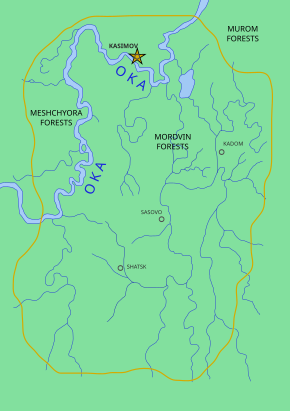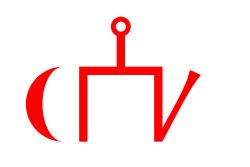Kasimovský chanát
| Kasimovský chanát Касыйм ханлыгы Касыйм патшалыгы Касимовское ханство Касимовское царство
| |||||||
geografie
| |||||||
| obyvatelstvo | |||||||
národnostní složení: | |||||||
| státní útvar | |||||||
vznik: | 1452 – nabytí nezávislosti | ||||||
zánik: | 1681 – ruská anexe | ||||||
| státní útvary a území | |||||||
| |||||||
Kasimovský nebo také Kvasimský chanát (tatarsky Касыйм ханлыгы, Касыйм патшалыгы; rusky Касимовское ханство, Касимовское царство), nepřesně též „Kasimovské carství“, byl vazalský stát velikého knížectví moskevského, založený Vasilijem II. pro tatarského emigranta "careviče" Qasima roku 1452. Existoval do roku 1681. Pod jeho kontrolou byla dnešní Rjazaňská oblast. Hlavním městem byl Kasimov, ležící na řece Oce.

Seznam chánů
- Qasim (1452–1468)
- Danijar (1468–1486)
- Nur Devlet (1486–1491)
- Satylgan (1491–1506)
- Janan (1506–1512)
- Šeich Aulijar (1512–1516)
- Šahghali (1516–1519) – první období
- Canghali (1519–1531)
- Safa Geraj (1532–1535)
- Šahghali (1535–1567) – druhé období
- Simeon Bekbulatovič (1567–1573)
- Mustafa Ali (1584–1590)
- Uraza-Mohammed (1600–1610)
- Arslanghali (1614–1627)
- Sajed Borhan (1627–1679)
- Fatima Soltan (1679–1681)
Odkazy
Reference
V tomto článku byly použity překlady textů z článků Qasim Khanate na anglické Wikipedii a List of Qasim khans na anglické Wikipedii.
Související články
Média použitá na této stránce
Autor: Лобачев Владимир, Licence: CC BY-SA 3.0
In the Illustrated Chronicle of Ivan the Terrible, there is an image of the banner of Ivan the Terrible in the Kazan campaign — a bifurcated white one with the image of the Savior and an eight-pointed cross above it. According to other sources, the banner was red instead of white. A copy of this banner, which has been restored many times, is still kept in the Kremlin Armoury.
Autor: Vorziblix, Licence: CC0
The flag of the Golden Horde, as shown in Angelino Dulcert's 1339 map. A similar flag appears in the later Catalan Atlas (1375), providing corroboration.
See also Early Mongol Flags at crwflags.com:
- One of the charges is a crescent and the other looks like a simplified form of the tamga from the flag of Idel Ural. On different copies of the flag, the crescent has different size; it is often smaller than shown here, sometimes even reduced into a simple oblique stroke and conjoined with the other charge into a si[n]gle symmetrical object; the other charge also sometimes lacks the oblique part [2, 3]. It was obviously difficult to draw the charges always the same way. The cities with this flag which are easy to identify are [2, 7, 8]: Sarai, the capital (spelled Sarra) - there is also a depiction of the ruler, "Jani Beg Lord of Sarai" ("Jambech senyor de Sarra"); Tana, present-day Azov, Russia; and Urgench, Uzbekistan (spelled Organci, with a cedilla under the c; nowadays ruined). This flag is a variant of the flag of "Emperor of Sarai" ("Emperador de Sara") from "Libro del conoscimiento de los reinos" [7] and might be the one that had really existed, considering the similarity of its charges with those from the flag of Idel Ural.
- [2] Enciclopedia universal ilustrada, vol. XXI, Espan~a Madrid: Espasa-Calpe S.A., 1968
- [3] Istorija otkric'a i istraz<ivanja, vol. I: Poc<etak istraz<ivanja; Mladinska knjiga, Ljubljana, 1979; Original title: A History of Discovery and Exploration, vol. I: The Search Begins;(C) 1973 Aldus Books Limited, London
- [7] Libro del Conoscimiento. Viajes medievales, vol. I Madrid: Fundacio'n Jose' Antonio de Castro, 2005 ISBN 84-96452-11-5 (complete edition) ISBN 84-96452-12-3 (vol. I) [e9s50]
- [8] A[p]pendices. (Ibid.)
- Tomislav Todorovic, 21 April 2007
Autor: unknown, Licence: Attribution
Autor: Samhanin, Licence: CC BY-SA 4.0
Banner of Dmitry Donskoy (colored according to medieval chronicles)





